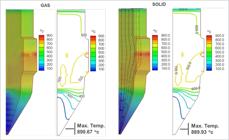Abstract
The Direct Reduction (DR) process has been growing worldwide, and there are strong context suggestions that it will grow even more. One of these factors is the environmental pressure that occurs worldwide, and there are already projects to migrate Blast Furnace route steel plants to the Direct Reduction (DR) route, due to its smaller carbon footprint. Considering the importance of this process and the challenges of carrying out experimental tests on a pilot scale, an adequate way to evaluate the process and its impacts is through numerical simulations. There are different techniques applied to models that describe the counter-current reactor in the DR process, but none of them account for the clustering phenomenon. Clustering occurs because of the sintering of the metallic iron on the surface of the pellets in such a way that they attach to each other, forming clusters that hinder the gas flow through the shaft. The present study attempted to adapt a numerical model of a DR process to account for the effect of the cluster formation. Some clustering index equations from literature and some developed as part of this study were used and tested in the model, as a function of temperature, by varying the solid volume fraction in the control unit. The equation that resulted in the adjusted output closest to the current empirical value was implemented in the model and proved to be successful.
Keywords:
iron ore; direct reduction; simulation; clustering

 Thumbnail
Thumbnail
 Thumbnail
Thumbnail
 Thumbnail
Thumbnail
 Thumbnail
Thumbnail



